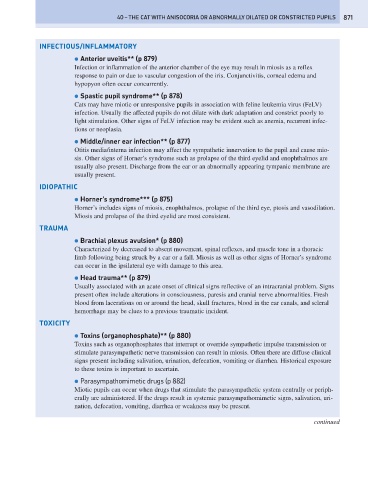Page 879 - Problem-Based Feline Medicine
P. 879
40 – THE CAT WITH ANISOCORIA OR ABNORMALLY DILATED OR CONSTRICTED PUPILS 871
INFECTIOUS/INFLAMMATORY
● Anterior uveitis** (p 879)
Infection or inflammation of the anterior chamber of the eye may result in miosis as a reflex
response to pain or due to vascular congestion of the iris. Conjunctivitis, corneal edema and
hypopyon often occur concurrently.
● Spastic pupil syndrome** (p 878)
Cats may have miotic or unresponsive pupils in association with feline leukemia virus (FeLV)
infection. Usually the affected pupils do not dilate with dark adaptation and constrict poorly to
light stimulation. Other signs of FeLV infection may be evident such as anemia, recurrent infec-
tions or neoplasia.
● Middle/inner ear infection** (p 877)
Otitis media/interna infection may affect the sympathetic innervation to the pupil and cause mio-
sis. Other signs of Horner’s syndrome such as prolapse of the third eyelid and enophthalmos are
usually also present. Discharge from the ear or an abnormally appearing tympanic membrane are
usually present.
IDIOPATHIC
● Horner’s syndrome*** (p 875)
Horner’s includes signs of miosis, enophthalmos, prolapse of the third eye, ptosis and vasodilation.
Miosis and prolapse of the third eyelid are most consistent.
TRAUMA
● Brachial plexus avulsion* (p 880)
Characterized by decreased to absent movement, spinal reflexes, and muscle tone in a thoracic
limb following being struck by a car or a fall. Miosis as well as other signs of Horner’s syndrome
can occur in the ipsilateral eye with damage to this area.
● Head trauma** (p 879)
Usually associated with an acute onset of clinical signs reflective of an intracranial problem. Signs
present often include alterations in consciousness, paresis and cranial nerve abnormalities. Fresh
blood from lacerations on or around the head, skull fractures, blood in the ear canals, and scleral
hemorrhage may be clues to a previous traumatic incident.
TOXICITY
● Toxins (organophosphate)** (p 880)
Toxins such as organophosphates that interrupt or override sympathetic impulse transmission or
stimulate parasympathetic nerve transmission can result in miosis. Often there are diffuse clinical
signs present including salivation, urination, defecation, vomiting or diarrhea. Historical exposure
to these toxins is important to ascertain.
● Parasympathomimetic drugs (p 882)
Miotic pupils can occur when drugs that stimulate the parasympathetic system centrally or periph-
erally are administered. If the drugs result in systemic parasympathomimetic signs, salivation, uri-
nation, defecation, vomiting, diarrhea or weakness may be present.
continued

